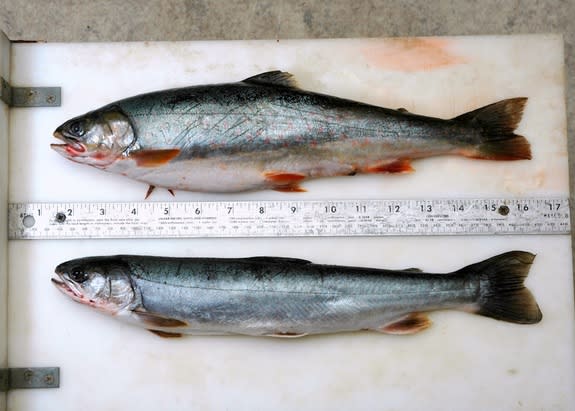Trout Guts Balloon for Yearly Gorge
Forget Thanksgiving: In the world of gorging, the Dolly Varden trout has humans and their holidays beat. A new study finds this trout feasts once a year, expanding its gut up to four times the usual size to make the space.
The findings are important for the conservation of this large, silvery fish, which eats the eggs of spawning sockeye salmon. Wild salmon are in trouble across North America, which could cause a domino effect among other fish populations that depend on the spawning season for most of their yearly food.
"If, for some reason, the salmon didn't come back, undoubtedly lots and lots of these fish wouldn't survive," said study researcher Morgan Bond, a doctoral student at the University of Washington. [Bounds of Biodiversity: Wildlife at Risk]
Mystery trout
Dolly Varden trout grow to about 2 feet (60 centimeters) long. During salmon spawning season in the late summer or early fall, the trout lurk as female salmon root in riverbeds to create nests for their eggs. All this digging turns up unhatched eggs from previous lays, which Dolly Varden view as a sumptuous feast. In the monthlong spawning season, the trout can put away a third to a half-pound (150 to 230 grams) of eggs each day.
Eating a quarter of their body weight daily for a month is no easy task. Bond and his colleagues stumbled upon how these fish do it while researching the trout in Alaska's Alec River, in the Chignik Lake watershed.
They found large Dolly Varden hanging out in the upper portion of the watershed when, by all expectations, they should have been at sea. Like salmon, Dolly Varden migrate between fresh and saltwater, though unlike salmon, they do so on an annual basis, making the trip and spawning multiple times.
Fasting fish
At first, the researchers thought the fish must have found a secondary food source in the freshwater, since it's a lack of food that drives them seaward. Instead, they found that the fish just weren't eating for the 10 to 11 months when the salmon aren't spawning.
"They basically are fasting themselves right down to the brink of death," Bond told LiveScience. "They're really skinny, there's almost no fat left in their body, and then days later, the salmon show up."
What's even stranger is that the fish actually change the size of their digestive tracts to accomplish this fasting feat. During spawning season, the fish's digestive tracts could nearly quadruple in size. And the fish aren't just stretching out their stomaches — they're actually adding new gut tissue. This is an evolutionary advantage, because even at normal size, the digestive tract uses almost a third of the fish's resting energy. Temporarily growing and then shrinking the gut allows fish to shed that energy-sucking tissue in seasons when they hardly eat at all.
"The fact that these fish can change the size of their organs to change how much energy they need just to live is a really novel thing," Bond said. "Nobody's ever showed that in wild fish before."
Conserving the food web
Along with Bond's other work, the results reveal that Dolly Varden live in lakes until about age 3, at which point they spend a few years shuttling back and forth between the ocean and freshwater, following food. Around age 5 or so, the fish stop their summer trips to the sea and start staying put in lakes and rivers, fasting until the sockeye salmon bring them a smorgasbord of eggs.
The strategy works well in the Chignik Lake watershed, Bond said, where fishing is strictly regulated and there are more than enough salmon eggs to go around — so many that it became hard for the researchers to lure the trout with bait during spawning season.
In the lower 48 states, though, salmon populations are severely depleted, Bond said. Conservation efforts take salmon from rivers pre-spawning and move them to hatcheries to lay their eggs. It's a strategy that ensures more salmon eggs survive, but could have ramifications for the creatures that depend on the spawning season for food.
"It's sort of an interesting dynamic where we'd like to see the fishery regulated not only to provide enough fish for returning the salmon population, but also to provide enough of these [egg] subsidies for the Dolly Varden and birds and bears and other organisms that rely on that subsidy," Bond said.
The researchers report their results today (March 20) in the Journal of Animal Ecology.
Follow Stephanie Pappas on Twitter and Google+. Follow us @livescience, Facebook & Google+. Original article on LiveScience.com
Copyright 2013 LiveScience, a TechMediaNetwork company. All rights reserved. This material may not be published, broadcast, rewritten or redistributed.



